|
MITERED SQUARE PANEL
Leg Squares:
Work a column of 8 squares, working Square
A, followed by 7 of Square B.
Work 4 further columns of squares, each formed
by working Square C, followed by 7 of Square
D. You will have a rectangle that is 5 squares
wide and 8 squares deep.
Note: If you wish to make the leg of the
sock longer, work more columns of squares.
It is a good idea to weave in ends after
each column of squares is completed.
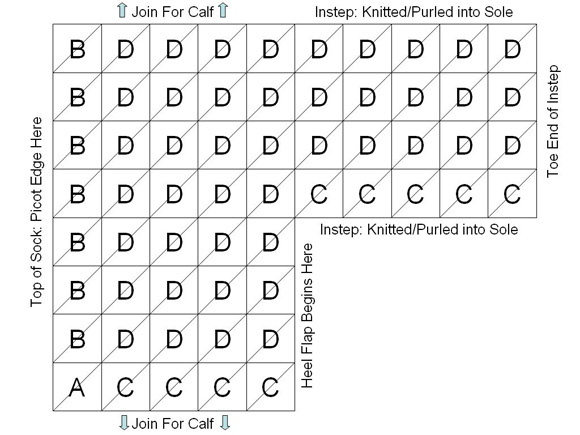
Instep Squares:
Beginning at edge of 4th square from bottom
of previous column, work a column of 4
squares (see diagram above). Each column
is formed by working Square C, followed
by 3 of Square D.
Work 4 further columns of squares; instep
is 5 columns wide.
Note: To lengthen sock by 1 inch or more,
work an additional column of squares. To
shorten foot, work one fewer colum of squares.
Length may be fine-tuned by working more
rows of stockinette st before working toe.

Referring to diagram above, join edges of
panel labeled “Join For Calf” together
to form leg of sock, sewing as shown in photo
below. The seam will show, but will be inobtrusive
and will lay flat on both inside and outside
of sock.
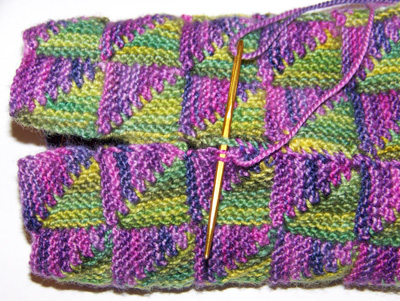
HEEL FLAP
Using CC and with RS facing, pick
up and k sts along edge of mitered square
panel marked “Heel Flap Begins Here” in
diagram above, as follows: 1 st in first
corner, 8 sts in each square, 1 st in corner.
34 sts.
Work heel flap over these sts as follows:
Row 1 [WS]: K1, p to last st, sl 1.
Row 2 [RS]: K1, [sl 1, k1] to last st, yf,
sl1.
Repeat these 2 rows 16 times more. There
are 17 slipped sts along each side edge of
flap.
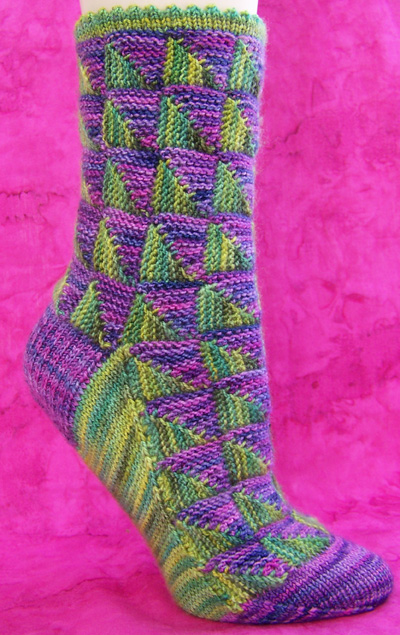  TURN HEEL TURN HEEL
Row 1 [WS]: Sl 1, p16, p2tog, p1.
Turn work.
Row 2 [RS]: Sl 1, k2, ssk, k1. Turn work.
Row 3 [WS]: Sl 1, p3, p2tog, p1. Turn work.
Row 4 [RS]: Sl 1, k4, ssk, k1. Turn work.
Row 5 [WS]: Sl 1, p5, p2tog, p1. Turn work.
Row 6 [RS]: Sl 1, k6, ssk, k1. Turn work.
Row 7 [WS]: Sl 1, p7, p2tog, p1. Turn work.
Row 8 [RS]: Sl 1, k8, ssk, k1. Turn work.
Row 9 [WS]: Sl 1, p9, p2tog, p1. Turn work.
Row 10 [RS]: Sl 1, k10, ssk, k1. Turn work.
Row 11 [WS]: Sl 1, p11, p2tog, p1. Turn work.
Row 12 [RS]: Sl 1, k12, ssk, k1. Turn work.
Row 13 [WS]: Sl 1, p13, p2tog, p1. Turn work.
Row 14 [RS]: Sl 1, k14, ssk, k1. Turn work.
Row 15 [WS]: Sl 1, p15, p2tog. Turn work.
Row 16 [RS]: Sl 1, k16, ssk. Do not turn
work.
18 sts remain.
Break CC.
GUSSET
Join MC at end of last row (where
CC was cut).
Using a new needle and with
RS facing, pick up and k 17 sts (1 st in
each slipped st) along adjacent edge of flap
and 3 sts in space between flap and insole.
20 sts on this needle.
Turn work.
Next Row [WS]: Use tip of needle to pick
up 1 st in edge of adjacent square of instep;
p this st together with first st on needle,
p to end of needle, p first 9 sts of heel;
using a second needle, p remaining 9 sts
of heel, pick up and p 17 sts along remaining
edge of heel flap and 3 sts in space between
top of flap and instep. 58 sts: 29 sts on
each needle.
In the directions that follow, when instructed
to pick up a st, use the tip of the left
needle to pick up a st in the adjacent square
of the instep flap. Pick up 8 sts in each
square before proceeding to the next square.
Do not pick up sts in the corner of each
square, as the point where the colors meet
will tend to pull and leave a hole.
Work gusset, joining work to edges of instep
flap as follows:
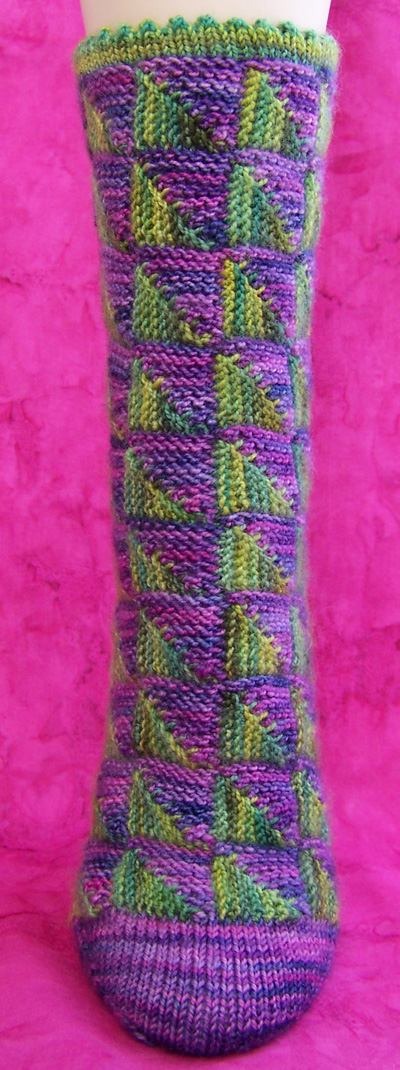  Row 1 [RS]: Pick up st and [k2tog] with first
st on needle, k2tog, k to last 3 sts on second
needle, ssk, pick up st and [k2tog] with
last st on needle. 56 sts. Row 1 [RS]: Pick up st and [k2tog] with first
st on needle, k2tog, k to last 3 sts on second
needle, ssk, pick up st and [k2tog] with
last st on needle. 56 sts.
Row 2 [WS]: Pick up st and [p2tog] with first
st on needle, p to last st on second needle,
pick up st and [p2tog] with last st on needle.
Row 3 [RS]: Pick up st and [k2tog] with first
st on needle, ssk, k to last 3 sts on second
needle, k2tog, pick up st and [k2tog] with
last st on needle.
Repeat Rows 2 and 3 nine times more. 36 sts;
18 sts on each needle.
SOLE
Row 1 [WS]: Pick up st and [p2tog] with
first st on needle, p to last st on second
needle, pick up st and [p2tog] with last
st on needle.
Row 2 [RS]: Pick up st and [k2tog] with first
st on needle, k to last st on second needle,
pick up st and [k2tog] with last st on needle.
Repeat these 2 rows until end of instep flap
is reached, ending with a RS row.
Break MC.
TOE
Try on sock to determine whether extra
length is needed. The toe should be worked
when sock is 1.5 inches less than desired
length; if the sock at this point is not
long enough, extra rounds will need to be
worked in the next step.
Using a new needle and CC, pick up and k
18 sts along edge of first two squares at
end of instep flap; using another needle,
pick up and k 18 sts along edge of remaining
2 squares. These needles will be designated
Needles 3 and 4; the needles which hold the
sts of the sole will be designated Needles
1 and 2.
72 sts: 18 sts on each needle.
K 1 round.
If necessary, continue in stockinette st
until work measures 1.5 inches less than
desired length.
Decrease Round: K1, ssk, k to end of Needle
1; k to last 3 sts of Needle 2, k2tog, k1;
k1, ssk, k to end of Needle 3; k to last
3 sts of Needle 4, k2tog, k1.
K 1 round.
Repeat these 2 rounds 8 times more. 36 sts;
9 sts on each needle.
Work Decrease Round 4 times more. 20 sts;
5 sts on each needle.
Slip sts from Needle 2 to Needle 1. Slip
sts from Needle 3 to Needle 4.
Graft sts on Needle 1 to sts on Needle 4.
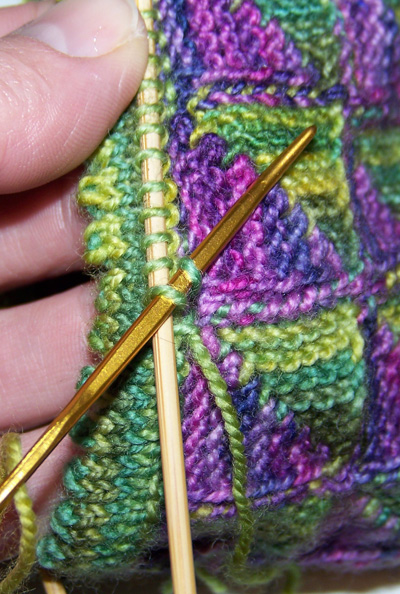  CUFF CUFF
Using MC and with RS facing, pick up
and k 60 sts (15 sts for every 2 squares)
around upper edge of sock.
Distribute sts
so that each needle holds an even number
of sts, and join to work in the round.
K 5 rounds.
Next Round: [Yo, k2tog] to end.
K 5 rounds.
Break yarn, leaving a tail approx. 36 inches
long.
Turn sock inside out.
Sew live sts to inside of cuff as directed
in linked article (see Pattern Notes). |

